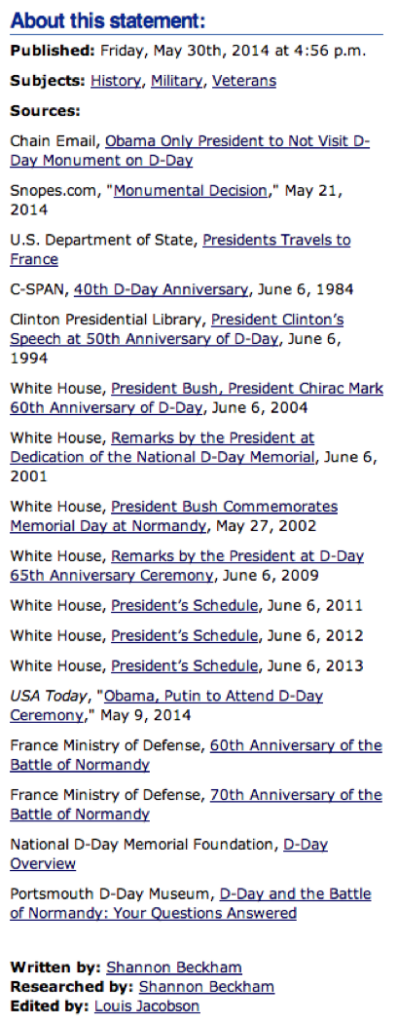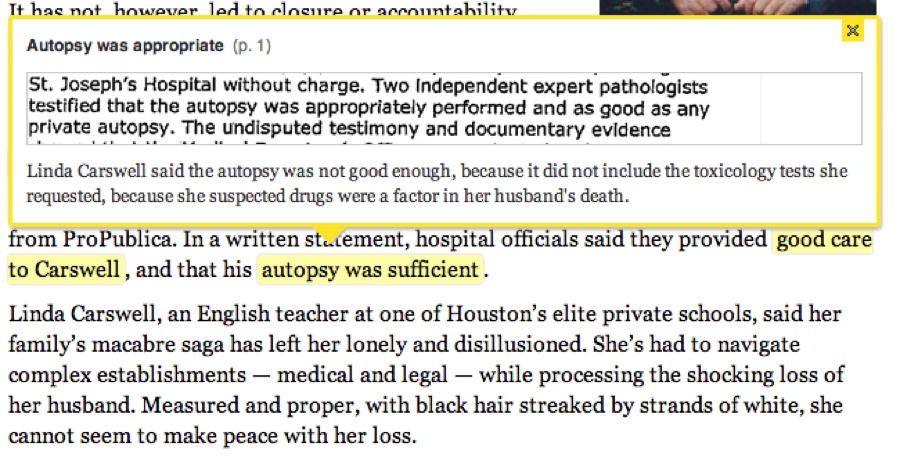One important way to build trust in reporting is to show the audience the sources it relies upon. There are several ways to do this.
I. Share source material
Digital platforms don’t suffer the same time and space constraints as print, television and radio. This freedom offers new opportunities to incorporate and disclose source material, and to be clear about content changes.
One core feature of the web — the hyperlink — offers an easy and powerful way to point to the sources and information that have played a role in telling a story. Links are way to offer proof, in effect footnotes, without breaking the flow of narrative work or adding unwanted narrative to shorter or more visual forms. Because of this enormous advantage, anyone producing journalism in the digital age must make linking out to sources a fundamental practice that applies to all work.
Use workflow checkpoints to force linking
Articles, multimedia projects, video, apps, and other pieces should incorporate links that point to sources and additional information. This is both good journalism and a service to the community.
A simple rule for linking might be this: if a claim or fact was gathered and verified online, it should be supported by a link.
The Register Citizen in Connecticut has evangelized the use of links as part of its effort to shift to a digital workflow, explained Matt DeRienzo, the state’s group editor for Digital First Media.
“We audited our site in terms of how much we were linking out to sources and showing the studies we were quoting,” he said.
They saw work to be done, so the paper’s managers implemented a new practice: Copy editors send reporters back any story that didn’t include links. (The editors also make an effort to add links.)
“That has improved things tremendously,” DeRienzo said. “We’re trying to make that part of the DNA.”
List all the sources
Since its earliest days, PolitiFact, the Pulitzer Prize-winning fact-checking website, has listed all of the sources it consulted in putting together each fact-check. This list is published in addition to including links within the text of fact-check articles.
“We include the interviews we do, the documentation we look at, any studies we reviewed, any news reports we looked at,” said PolitiFact editor Angie Holan.
Each fact-check must have an accompanying source list, or the reporter is told to go back and show their sources, she said. There is also a field in the PolitiFact CMS where the sources are entered, and a fact check can’t be published unless it has been filled in, according to Holan.
“I think it would be hard to get people to do if we had to nag them to do it and they could literally publish without doing it,” she said.
This practice provides a roadmap to curious readers who want to know how PolitiFact arrived at its verdict. It helps build credibility.

As shown in this example, PolitiFact’s source list can be extensive. It includes the publication date (down to the minute) of the fact-check, as well as the publication information and hyperlink for each item. Finally, it includes a full list of the journalists responsible for the fact-check. It in effect says, “This is who we are, and how we did this work. See for yourself.”
“In a skeptical age people do not take even respected media reports at face value,” Holan said. “They are very cautious about accepting what the media says, and I think they want to investigate for themselves … in other cases it merely shows people that we looked at the relevant evidence.”
Another benefit of making a list of sources part of every fact check is that it provides PolitiFact with a repository of useful sources.
Holan said the newsroom’s internal source list where reporters are supposed to enter contact information for sources is rarely updated. Making the sources public ensures they have a place to revisit useful information.
“If [the source list] was not public, it would not get done,” she said. “We use the source list ourselves just as much [as the public].”
Show the source documents
ProPublica’s Explore Sources goes one step further in disclosing sources.
It’s a tool that integrates source document excerpts into a story, so readers can view related documentation as they go. The documents must first be uploaded to DocumentCloud, a free service. (As of now ProPublica has not open-sourced the code for Explore Sources)
Explore Sources debuted in a 2011 story that incorporated excerpts from 64 documents that reporter Marshall Allen gathered. He used Explore Sources to link specific excerpts to relevant passages in his story.

Explore Sources shows the source document as a pop-up window when a reader clicks on a highlighted passage in the story.
II. Show changes to content
An oft-repeated maxim today is that “journalism is a process, not a product.”
The stories we report don’t stop just because we’ve hit publish. They are updated to incorporate new information, and these additions should be disclosed.
One model for capturing the changes to content over time is Wikipedia. Every article on its site includes a “History” tab at the top that shows all of the changes made to the article, and by whom.
For example, the history of the Wikipedia article about Joseph Pulitzer can be accessed here. This level of total transparency is great; but the page is difficult for the average user to understand.
A more user-friendly way to show a revision history would be welcome, but as of now this is not something news organizations are putting effort into. (BuzzFeed’s deputy editor-in-chief, Shani Hilton, told the Poynter Institute the web publisher is considering it.)
For now most news organizations handle updates in one of two simple ways:
- Add a note at the top or bottom of the piece of content that begins, “Update: This article was updated to … ” and that goes on to list the basic nature of the update made. Then the updated information itself is incorporated into the content by rewriting/adding as needed.
- Add an update note at the top or bottom of the piece that details all of the new information, thus leaving the original content intact.
The first option places all of the updated information within the context of the content itself and simply adds a note of disclosure.
The second places all of the new information within the update note itself, preserving the rest of the content as it was originally published. In both cases, it’s best practice to add the date (and even the time) of the update, so a reader can see how the story evolved.
Both options note clearly that content has changed from when it was first published. This is a critical difference with old tradition of a “writethru” that would see a story rewritten again and again without any record of the changes being made. Similarly, TV and radio reports would often be updated or re-cut with new information, and not include a note about previous versions.
Just because we can update something online without it being evident to the audience doesn’t mean we should. The principle of transparency suggests that online it’s essential to note when and how content is changing because it continues to exist in the same place, and because people may be linking to it. Adding updates also gives a reason for people to come back and read the content again, thereby increasing traffic and engagement.
For particularly fast-moving stories, many organizations are moving away from static article pages toward using live blog tools. Live blogs automatically capture the chronological timeline with full attribution and time stamps, offering automated transparency.
Core principles
When adding updates to content, consider these five best practices:
- Be clear about the nature of the update. Why are you updating the content, and what information has been added? An update note that only reads, “This article was updated to reflect new information” does not serve the reader.
- Note when and why was it added. Make it clear why you added new information by citing the source and the addition. Also indicate the date and time of the update. This communicates to the reader a sense of time and place.
- Think about readability. Clarity is the first priority in an update. But the placement and overall readability is also important. If you have a major update that renders much of the previous content obsolete, the best option may be to add the update at the top and include all of the new information. If you expect a story to require multiple updates, flag that for the reader and think about how you can set up the page so that they can easily understand how the story is progressing. (Or think about a live blog.)
- Have a review process. Who signs off on the update? It’s unwise to have reporters add information or updates without it being approved by an editor or producer.
- Updates are not corrections. If you’re making changes due to a factual error, critical omission or other mistake, don’t label it an update. If you are fixing an error, then it should be labeled a correction. (See section five of this study for advice on making digital corrections.)
Obstacles to expect and overcome: If your organization has been producing content for legacy platforms, including links or publishing source lists may not be standard operating procedure. As shown by The Register Citizen and PolitiFact, the way to change the culture and make linking a regular practice is to require reporters or producers to add them to all work, and, like PolitiFact, to even build this into the CMS. It has to become a habit. Some journalists may also push back on noting updates to content. A first step is to create boilerplate update text that can be used as the basis for adding updates, making the process easy to do. A second step is to create a clear policy that fast moving stories go to a live blog or another format better suited to updates, thereby preventing journalists from having to make repeated updates.
Share with your network
Build credibility through transparency
You also might be interested in:
As research continues to inform this slice of the news industry, we’ll continue learning, too. Who gets to be called a journalist in 2025 and beyond? What is the future of trustworthy information, especially considering the access to and trust for online content creators? How might journalism adapt to the rise, or co-opt the styles, of news influencers?
What if we started looking at our output as a product, not a service? Too often, we think "product" means a fancy app or a new website. But product isn’t about tech. It’s about intention.
When we began asking what kind of stories still mattered to Baca County, we realized many of them weren’t “breaking news” but generational memory. And the paper was the last remaining platform that treated those memories with care and context.




